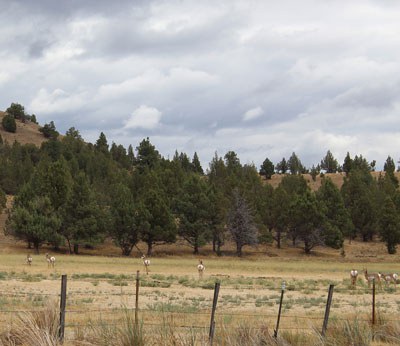Pronghorn might be one of my favorite creatures that live in Oregon. Perhaps it’s their affinity for the sagebrush steppe, which I share. Or maybe it's because I think there’s something regal and majestic about them, with impressive skills to boot. It could even be because I'm awed by how well-adapted they are to their environment. But enough about my biased opinions on the pronghorn. Let's get to know these striking animals!
Pronghorn (Antilocapra Americana) are often called antelope, but are not actually in the antelope family. They can be found in western North America, from the southern prairie provinces of Canada down to northern Mexico, and as far east as Texas and South Dakota. In Oregon, you can find them in the eastern half of the state in grasslands and sagebrush steppe. There are an estimated 25,000 pronghorn in Oregon.
Pronghorn get their name from their forked horn. Males have longer prongs (around 10-12 inches), while females often just have a nub (up to 3 inches). Their horns are actually not a true horn (nor a true antler). Typically, horns are a permanent part of the animal, have only one point, and are made of compressed keratin that grows from a bony core (keratin is found in our hair and fingernails). This is different from antlers, which are made of bone, multi-branched, and shed every year. Pronghorn, however, have horns that are shed annually and are forked!
One of the main things pronghorn are known for is their speed. While 45 miles per hour is common for these speedsters, they have been clocked at up to 55 miles per hour. This makes them the fastest ungulate in North America and the second fastest land mammal in the world (after the cheetah). Now that’s impressive! And if you’re wondering about a running contest between a pronghorn and a cheetah, pronghorn may just have the advantage as they can maintain their high speeds for much longer than a cheetah can.
Another way they have adapted to their environment is through their fur. Their light brown fur blends in with dry lands and their white underbelly and lower neck deflect heat rising from the ground. They also have an outer layer of air-filled hairs that help them stay warm in the winter. Come spring, they shed that coat and can raise their hairs to stay cool.
The pronghorn diet consists of herbaceous leaves. They particularly enjoy longleaf phlox, wallflower, and Hooker’s balsamroot. In the winter, they will browse on sagebrush tips and the occasional grasses. Pronghorn can often go for weeks without drinking water, getting moisture from the food they eat instead.
Pronghorn breed in the fall. They typically have 1-2 young that are born in May or June. Pronghorn newborns can take their first steps just 30 minutes after birth and at four days old, they can already outrun humans.
Another interesting fact about pronghorn is that they have no close relatives in North America (or on any other continent)! They are truly originals.
The Land Trust-protected Aspen Valley Ranch is an important habitat for pronghorn. In fact, you’ll often see a herd of them running off into the distance. Of the 3,748 acres currently protected, around 65% is considered prime pronghorn habitat. This is just one of the reasons the Land Trust has helped conserve Aspen Valley Ranch. Take a virtual tour of the ranch!
I hope your newfound knowledge about pronghorn has made you fall in the love with them as well!
Learn about other local wildlife:


